Marilyn Monroe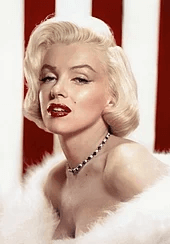
Marilyn Monroe (named Norma Jeane Mortenson initially) was born on June 1, 1926, in New York City and passed away on August 4, 1962, in Los Angeles. She was an American entertainer, artist, and model. She became one of the most famous celebrity images of the 1950s and mid-1960s, as well as an insignia of the period's sexual unrest, because of her comedic "blonde stunner" jobs. For ten years, she was a top-charged entertainer, and her movies earned $200 million (identical to $2 billion in 2021). Monroe has stayed a significant mainstream society symbol long after her passing. The American Film Establishment positioned her 6th on their rundown of the best female screen legends from Hollywood's Brilliant Age in 1999. Monroe was brought up in Los Angeles and spent most of her experience growing up in shelter homes before her wedding at sixteen. During World WarII, she worked in a processing plant when she met a photographic artist from the Primary Movie Unit. This prompted an effective centerfold displaying vocation and brief film contracts with Twentieth Century Fox and Columbia Pictures. She marked another agreement with Fox in late 1950 after a line of minor film jobs. She rose to unmistakable quality over the following two years, showing up in comedies, for example, "As Youthful as You Feel" and "Foolishness," as well as dramatizations like Conflict Around evening time and try not to Thump. When it was uncovered that she had postured for naked photos before turning into a star, she confronted an outrage; however, the story didn't hurt her profession and, on second thought, expanded her interest in her movies. Monroe was one of Hollywood's most attractive stars by 1953, with driving jobs in the film noir Niagara, which depended on her sex request, and the comedies Men of honor Favor Blondies and How to Wed a Mogul, which laid out her star picture as an "idiotic blonde." Her stripped pictures were utilised as the dream boat and on the front of the primary issue of Playboy that same year. Through her profession, she was instrumental in the creation and the board of her public picture. However, she was disheartened when she was pigeonholed and came up short by the studio. She was momentarily suspended in mid-1954 for declining to partake in a film project. Yet, she got back in The Long-term Tingle (1955), one of her vocation's most significant film industry victories. At the point when the studio would not change Monroe's agreement, she laid out her film creation organization in 1954. She gave 1955 to the organization's turn of events and started concentrating on technique acting at the Entertainers Studio with Lee Strasberg. Later that year, Fox gave her a new contract with more authority and a higher salary. Her resulting jobs remembered a widely praised turn for Transport Stop (1956) and her most memorable free creation, The Sovereign, and the Showgirl (1957) (1957). She won a GoldenGlobe for Best Entertainer for her presentation in the movie Some Like It Hot (1959). Her last completed film was the show The Mavericks (1961). Monroe's troubled personal life drew a lot of attention. She battled addiction and mood disorders. Her union with previous baseball player Joe DiMaggio and writer Arthur Mill operator were both exceptionally promoted. However, both finished separately. She passed on from barbiturates glut at her Los Angeles home on August 4, 1962, at 36 years old. She demise due to suicide. Life and Career1926-1943: Childhood and First Marriage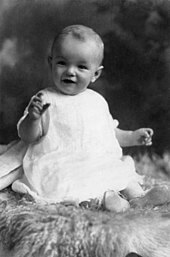
Monroe was brought into the world on June 1, 1926, as Norma Jeane Mortenson at the Los Angeles Province Clinic in Los Angeles, California. Gladys Pearl Bread cook, her mom, was brought to the world in Piedras Negras, Coahuila, Mexico, to a poor Midwestern family who had moved to California when the new century rolled over. Gladys wedded John Newton Dough puncher, an oppressive man nine years her senior, when she was 15 years of age. They had two children, Robert (1917-1933) and Berniece (1917-1933) (1919-2014). She was conceded separation and sole authority in 1923, yet a Pastry specialist before long captured the kids and moved them to his local Kentucky. Monroe was not informed she had a sister until she was 12 years of age, and they initially met when Monroe was 17 or 18. Despite Gladys' lack of mental and financial preparation for a child, Monroe's childhood was stable and happy. Gladys set her girl in the provincial town of Hawthorne with zealous Christian temporary parents Albert and Ida Bolender. She likewise lived there for the initial half year until she needed to return to the city for work. She then began spending weekends with her daughter. Gladys purchased a little house in Hollywood with a credit from the Property holders' Advance Organization in the late spring of 1933 and moved seven-year-old Monroe in with her. They imparted the house to entertainers George and Maude Atkinson, as well as their girl Nellie. Gladys lost it in January 1934 and was determined to have jumpy schizophrenia. She was focused on the Metropolitan State Clinic in the wake of expenditure a while in a rest home. She spent the remainder of her life through emergency clinics, seldom seeing Monroe. Monroe became a state ward, and her mom's companion, Beauty Goddard, assumed responsibility for her and her mom's issues. Monroe's living situation changed frequently over the next four years. She lived with Atkinson for the initial 16 months and may have been physically manhandled during this time. She had forever been a bashful young lady, yet presently she falters and pulls out. She spent the summer of 1935 with Grace and her husband, Erwin "Doc" Goddard, as well as two other families. Grace placed her in the Los Angeles Orphans Home in September 1935. Monroe felt abandoned even though the orphanage was described as "a model institution" by her peers. "I could have done without my general surroundings since it was somewhat troubling... At the point when I heard that this was acting, I said that is what I need to be... A portion of my temporary families used to send me to the motion pictures to get me out of the house, and there I'd sit the entire day and way into the evening, up in front, there with the screen so large, a small child isolated, and I cherished it," Monroe said. Monroe found a more long-lasting home in Sawtelle's west side region in September 1938, when she moved in with Beauty's auntie, Ana Lower. She was an understudy at Emerson Middle School and went to Christian Science administrations with Lower consistently. Monroe was a typical understudy who succeeded at composing and adding to the school paper. Monroe returned to Van Nuys with the Goddards in early 1941 due to the elderly Lower's health problems. She started Van Nuys High School the same year. Doc Goddard's employer transferred him to West Virginia in 1942. Monroe confronted being returned to the shelter since California youngster security regulations kept the Goddards from removing her from the state. Thus, on June 19, 1942, soon after her sixteenth birthday celebration, she wedded their neighbor's 21-year-old boy, assembly line laborer James Dougherty. Monroe later dropped out of high school to become a housewife. She and Dougherty were confused, and she later expressed that she was "wasting away" during the marriage. Dougherty enrolled in the Trader Marine in 1943 and was positioned on St Nick Catalina Island, where Monroe went along with him. 1944-1948: Modelling and First Film Roles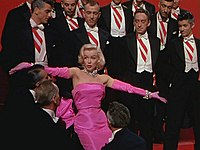
In April 1944, Dougherty was sent out to the Pacific, and he would stay there for most of the following two years. Monroe moved in with her parents-in-law and started work at the Radio plane Organization, a weapons production line in Van Nuys. In late 1944, she met photographic artist David Conover, who had been sent by the U.S. Armed force Flying corps' Most memorable Movie Unit to the industrial facility to shoot confidence-helping pictures of female specialists. Albeit her photos were generally not utilized, she quit working at the plant in January 1945 and started demonstrating for Conover and his companions. Resisting her conveyed spouse, she continued all alone and marked an agreement with the Blue Book Model Organization in August 1945. Monroe's figure was deemed more suitable for pin-up modeling than high fashion modeling by the agency, and she was primarily featured in advertisements and men's magazines. She fixed her hair and colored it blonde to make herself more employable. Monroe immediately became one of the organization's most aggressive and diligent models, as Emmeline Snively, the organization's proprietor; by mid-1946, she had shown up on 33 magazine covers for distributions like Exhibition, U.S. Camera, Laff, and Look. Monroe worked as a model under the alias Jean Norman on occasion. In June 1946, Monroe marked an agreement with an acting office through Snively. She was given a screen test by Ben Lyon, a twentieth Century-Fox leader, after an ineffective meeting at Central Pictures. Darryl F. Zanuck, the studio's head leader, was unamused. However, he gave her a standard half-year agreement to hold her back from marking with rival studio RKO Pictures. Monroe marked an agreement in August 1946, and she and Lyon picked the stage name "Marilyn Monroe." Lyon picked the top name since it helped him to remember Broadway star Marilyn Mill operator, and the latter was Monroe's mom's original surname. She separated from Dougherty, who was against her vocation, in September 1946. Monroe spent her initial half year at Fox figuring out how to act, sing, and dance, as well as watching the filmmaking system. Her agreement was reestablished in February 1947, and she got her first film jobs in Quite a while (1947) and Scudda Hoo! (1947), Feed, Scudda! (1948). She was likewise signed up for the Entertainers' Lab Theater, an acting school that shows Gathering Theater methods; she later expressed that it was "my most memorable taste of what genuine acting in a genuine show could be, and I was scared." Despite her energy, her educators thought she was excessively bashful and unreliable for a lifelong, and Fox didn't reestablish her agreement in August 1947. She got back to displaying while likewise maintaining odd sources of income at film studios, like working in the background as a moving "pacer" to keep the leads spot on at melodic sets. Monroe was resolute about turning into an entertainer and proceeded with her examinations at the Entertainers' Lab. She assumed a minor part in the play Style Liked at the Euphoria Hayden Theater. However, it just ran for a couple of exhibitions. She networked by visiting producers' offices, befriending gossip columnist Sidney Skolsky, and entertaining influential male guests at studio functions, which she had started at Fox. She turned into a companion and intermittent sex accomplice of Fox chief Joseph M. Schenck, who persuaded his companion and Columbia Pictures head leader Harry Cohn to sign her in Walk 1948. Rita Hayworth enlivened Monroe's glance at Columbia, and her hair was dyed bleach blonde. She started working with Natasha Lytess, the studio's head show mentor, who might be her tutor until 1955. Her main film at the studio was the low-spending plan melodic Women of the Ensemble (1948), in which she played a chorale young lady sought by a well-off man. She likewise went for the lead job in Born Yesterday (1950), yet her agreement was not reestablished when it lapsed in September 1948. Women of the Ensemble was delivered the next month and became a business disappointment. 1949-1952: Breakthrough Years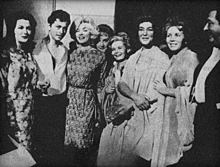 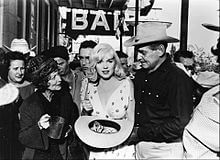
Monroe got back to displaying after her agreement with Columbia was terminated. She showed up in a Pabst lager business and presented in creative nudes for John Baumgarth schedules (under the name 'Mona Monroe'). Monroe had recently presented topless or in a two-piece for different artisans, including Duke Moran, and was quiet with bareness. She likewise met and wedded Johnny Hyde, the VP of the William Morris Organization, not long after leaving Columbia. Monroe was projected in a few movies through Hyde, including two widely praised works: Joseph Mankiewicz's theatrics About Eve (1950) and John Huston's film noir The City (1950). Despite having a couple of moments of screen time in the last option, she was referenced in Photoplay and, as per biographer Donald Spoto, "moved successfully from film model to serious entertainer." Hyde arranged a seven-year contract for Monroe with twentieth Century-Fox in December 1950. As per the agreement's terms, Fox might decide not to reestablish the agreement after every year. Only days later, Hyde died of a heart attack, leaving Monroe devastated. Monroe showed up in three modestly effective Fox comedies in 1951: As Youthful as You Feel, Love Home, and We should Make It Legitimate. As per Spoto, she was "basically a hot trimming" in every three movies. However, she got some essential recognition: Bosley Crowther of The New York Times referred to her as "wonderful" in As Youthful As You Feel, and Ezra Goodman of the Los Angeles Day to day News referred to her as "one of the most splendid promising actress" in Adoration Home. Her fame with crowds was developing too: she got a massive number of fan letters every week. She was named "Miss Cheesecake of 1951" by the military paper Stars and Stripes, mirroring the inclinations of troopers battling in the Korean Conflict. Monroe had a short relationship with chief Elia Kazan and dated a few different men, including chief Nicholas Beam and entertainers Yul Brynner and Peter Lawford. She started an exceptionally promoted sentiment with resigned New York Yankees baseball star Joe DiMaggio, perhaps of the most well-known sports figures of the time, in mid-1952. Monroe became entangled in outrage in 1952 when she uncovered openly that she had postured for a nudist schedule in 1949. The studio had found out about the photographs and that she was freely supposed to be the model half a month prior, and Monroe and the studio concluded that it was ideal to own up to them while focusing on the fact that she was down and out at that point. The methodology won her public help and expanded interest in her movies, for which she was currently given front and center attention. Monroe was highlighted on the front of Life magazine as the "Discuss Hollywood" as a result of the outrage, and tattle feature writer Hedda Container named her the "cheesecake sovereign" turned "film industry crush sovereign." Despite her newfound celebrity as a sex symbol, Monroe wanted to show off more of her acting abilities. Not long after starting her Fox contract, she started taking acting classes with Michael Chekhov and emulating Lotte Goslar and Conflict Around evening time. She tried not to Thump highlighted her different jobs. She played a fish cannery specialist in the previous show featuring Barbara Stanwyck and coordinated by Fritz Lang; to plan, she worked in a fish cannery in Monterey. The Hollywood Journalist said of her exhibition, "she merits featuring status with her brilliant understanding," and Assortment noted she "has a simplicity of conveyance that makes her a snap for notoriety." The last option was a spine chiller wherein Monroe played an intellectually upset sitter, and Zanuck utilized it to put Monroe through some severe hardship in a more emotional job. Pundits gave it blended surveys, with Crowther saying she was excessively unpracticed for the troublesome job and Assortment faulting the content for the film's concerns. Monroe's pigeonholing in comedic jobs that featured her sex request went on in her three different movies in 1952. In the film We're Not Hitched! As per its essayist Nunnally Johnson, her job as a wonder expo contender was made exclusively to "present Marilyn in two swimming outfits." She played a secretary in Howard Birds of prey's Silliness, inverse Cary Award, who is a "stupid, immature blonde, guiltlessly ignorant about the devastation her provocativeness causes around her." She showed up in a passing vignette as a nineteenth-century road walker in O. Henry's Full House, close by Charles Laughton. Monroe reinforced her picture as another sex image with exposure stunts that year, including wearing a particular outfit as Stupendous Marshal at the Miss America Event march and telling tattle editorialist Lord Wilson that she, as a rule, wore no clothing. Monroe was named the "its young lady" of 1952 by tattle journalist Florabel Muir before the year's over. Monroe fostered a standing for being hard to work with during this time, which would deteriorate as her profession advanced. She was often late or didn't show up by the means, didn't recall her lines, and required a few re-takes before she was happy with her presentation. Her dependence on acting mentors Natasha Lytess and Paula Strasberg afterward disturbed chiefs. Compulsiveness, low confidence, and anxiety in front of large audiences have all been faulted for Monroe's concerns. She hated her absence of control on film sets however had no such issues during photograph shoots, where she had more say over her exhibition and could be more unconstrained instead of the following content. She started utilizing barbiturates, amphetamines, and liquor to alleviate her nervousness and ongoing sleeping disorder, which exacerbated her concerns. However, she didn't turn out to be seriously dependent until 1956. As per Sarah Churchwell, a portion of Monroe's behavior, especially later in her vocation, was propelled by her male co-stars' and chiefs' loftiness and sexism. Additionally, biographer Lois Pennant has expressed that a considerable lot of her chiefs harassed her. 1953: Rising Star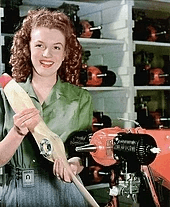

Monroe appeared in three movies in 1953, arising as a significant sex image and perhaps of Hollywood's most bankable entertainers. The first was Niagara, a Technicolor noir film in which she played a femme fatale plotting the homicide of her significant other, played by Joseph Cotten. Monroe and her make-up craftsman Allan "Whitey" Snyder had proactively made her "brand name" look, which included dim curved foreheads, fair skin, "sparkling" red lips, and a delight mark. As per Sarah Churchwell, Niagara was possibly Monroe's most sexual film. In certain scenes, Monroe's body was just covered by a sheet or a towel, which stunned contemporary crowds. The most famous scene in Niagara is a 30-second-remote chance behind Monroe in which she is seen strolling with her hips influencing, which was vigorously utilized in the film showcasing. At the point when Niagara was delivered in January 1953, ladies' clubs fought it as shameless, yet crowds adored it. While Assortment referred to it as "unoriginal" and "dreary," The New York Times said, "the falls and Miss Monroe are something to see," because while Monroe isn't "the ideal entertainer as of now... she can be tempting - in any event, when she strolls." Monroe kept drawing consideration by wearing scanty outfits, most strikingly at the Photoplay grants in January 1953, where she was named "Quickest Rising Star." William Travilla's creased "sunburst" midriff tight, profound decolleté gold lamé dress for Noble men Favor Blondies, which was scarcely found in the film, turned into a sensation. In response to such imagery, veteran actress Joan Crawford publicly condemned the behaviour as "unbecoming of an actress and a lady." While Niagara laid out Monroe's "look," her second film of 1953, the mocking melodic parody Honourable men Lean toward Blondies, solidified her screen persona as a "stupid blonde." The film depends on Anita Loos' novel and its Broadway variation, and it follows two "gold-digging" showgirls played by Monroe and Jane Russell. Betty Grable, twentieth Century-generally Fox's famous "blonde sensation" during the 1940s, was initially projected in Monroe's job; Monroe was rapidly overshadowing her as a star who could engage both male and female crowds. In June, she and Russell squeezed their hands and impressions in wet substantial external Grauman's Chinese Auditorium as a feature of the film's exposure crusade. Men of honor Incline toward Blondies trailed behind and became one of the year's most significant film industry victories. Both The New York Times' Crowther and Assortment's William Brogdon commended Monroe, lauding her presentation of "Jewels Are a Young lady's Closest companion" specifically; as indicated by the last option, she showed the "capacity to sex a tune as well as point up the eye upsides of a scene by her presence." Monroe made her TV debut in the Jack Benny Show in September, playing Jack's dream lady in the episode "Honolulu Excursion." In her third film of the year, How to Marry a Millionaire, she co-starred with Betty Grable and Lauren Bacall. It featured Monroe as a gullible model who collaborates with her companions to find well-off spouses, continuing in the strides of Courteous fellows Favour Blondies. It was the second film to be delivered in CinemaScope, a widescreen design Fox trusted would captivate crowds back to theatres as TV made film studios lose cash. Regardless of getting blended audits, the film was Monroe's greatest film industry accomplishment at that point. Monroe was named to the yearly Top Ten Lucrative Stars Survey in 1953 and 1954. As per Fox history specialist Aubrey Solomon, she was the studio's "most noteworthy resource" close by CinemaScope. Hugh Hefner highlighted Monroe on the cover and as the pin-up in the principal issue of Playboy in December 1953; Monroe didn't agree to the distribution. The cover picture was a photo of her from the Miss America Expo march in 1952, and the dream boat was one of her nude photos from 1949. 1954-1955: Conflicts with 20th Century-Fox and Marriage to Joe DiMaggio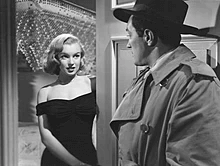
Monroe had become one of twentieth Century-greatest Fox stars, yet her agreement had not changed beginning around 1950, which implied she was paid not exactly different stars of her height and had no say over her ventures. Her endeavours to show up in films that didn't zero in on her as a dream boat had been defeated by the studio's head chief, Darryll F. Zanuck, who had significant areas of strength for an aversion of her and didn't completely accept that she would procure the studio as much income. He fired Monroe in January 1954 after she refused to start filming The Girl in Pink Tights, another musical comedy. This was front-page news, and Monroe acted quickly to counteract the negative publicity. On January 14, she married Joe DiMaggio at San Francisco City Hall. They then drove to San Luis Obispo before honeymooning outside Idyllwild, California, in the mountain lodge of Marilyn's lawyer, Lloyd Wright. They traveled to Japan 15 days after the fact, consolidating their "vacation" with his obligation to his previous San Francisco Seals mentor, Lefty O'Doul, to assist with preparing Japanese ball clubs. She went to Korea with Jean O'Doul, Lefty's significant other, from Tokyo, where she performed tunes from her movies for north of 60,000 US troops. Marines throughout four days. She was named the Photo play's "Most Famous Female Star" after returning to the US. Monroe agreed with Fox in Spring, promising another agreement, a $100,000 reward, and a featuring job in the film variation of the Broadway hit The Long term, Tingle. The last film Monroe made before his suspension, Otto Preminger's western Stream of No Return, was premiered in April 1954. She depicted it as a "Z-grade rancher film in which the acting came in second to the landscape and the CinemaScope cycle," yet crowds generally welcomed it. It was a flop when it was released in late 1954, with many critics dismissing Monroe's performance as vulgar. Monroe started shooting Billy More stunning's parody The Long-term Tingle in September 1954, co-featuring with Tom Ewell as the lady object of her married neighbor's sexual dreams. In spite of the way that the film was shot in Hollywood, the studio chose to create advance exposure by organizing the recording of a scene where Monroe is remaining on a metro grind on Lexington Road in Manhattan with the air exploding the skirt of her white dress.The shoot lasted several hours and drew nearly 2,000 people. The "metro grind scene" became one of Monroe's generally well known, and The Long-term Tingle became one of the year's greatest business triumphs after its June 1955 delivery. 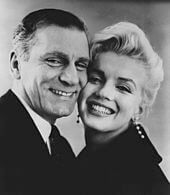
The exposure stunt put Monroe on worldwide front pages, however it additionally finished her union with DiMaggio, who was irate. His desire and controlling disposition had stressed the relationship all along; he was likewise genuinely harmful. Monroe petitioned for legal separation after just nine months of marriage in the wake of getting back from New York City to Hollywood in October 1954. After completing the process of recording for The Long-term Tingle in November 1954, Monroe moved toward the East Coast, where she and photographic artist Milton Greene laid out their own creation organization, Marilyn Monroe production (MMP), which was subsequently named "instrumental" in the studio framework's destruction. Monroe expressed that she was "burnt out on the standard, worn out sexy jobs" and guaranteed that she was not under agreement with Fox because the organization had neglected to satisfy its commitments, like paying her the guaranteed reward. In January 1955, she and Fox began a year-long legal battle. Monroe was generally derided in the press, and she was caricatured in the Broadway play Will Achievement Ruin Rock Tracker? (1955), in which her impersonator Jayne Mansfield played a moronic entertainer who dispatches her creation organization. Monroe moved to Manhattan after founding MMP and spent 1955 studying acting. She studied with Constance Collier and attended Lee Strasberg's Actors Studio method acting workshops. Because of her modesty, she developed a close relationship with Strasberg and his significant other Paula, getting private examples at their home, and before long, turned into a relative. She supplanted Natasha Lytess, her past acting mentor, with Paula; the Strasberg's stayed a significant impact on her until the end of her profession. Monroe began undergoing psychoanalysis reasonably because Strasberg believed that actors must confront and use their emotional traumas in their performances. Regardless of the continuous separation procedures, Monroe kept up with her relationship with DiMaggio; she additionally dated entertainer Marlon Brando and dramatist Arthur Mill operator. Elia Kazan had introduced her to Miller in the early 1950s. Monroe and Miller's affair became more severe after her divorce was finalized, and he separated from his wife in October 1955. The studio encouraged her to end it since the Mill operator was under FBI examination for socialist feelings and had been summoned by the House Unpatriotic Exercises Board. However, Monroe denied it. The relationship prompted the FBI to open an investigation into her. Monroe and Fox marked another seven-year contract before the year's over, as MMP would presently not have the option to fund films all alone, and the studio was anxious to have Monroe back. Fox would pay her $400,000 to make four movies and give her total innovative command over tasks, chiefs, and cinematographers. She would likewise be allowed to make one MMP film for each finished Fox film. 1956-1959: Critical Acclaim and Marriage to Arthur Miller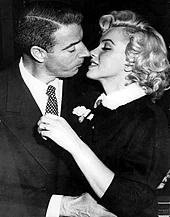
Monroe kicked off 1956 by announcing her victory over 20th Century-Fox. The press currently commended her choice to take on the studio; Time considered her a "clever money manager" and look anticipated that her triumph would act as "an illustration of the person against the crowd into the indefinite future." Conversely, Monroe's relationship with the Mill operator drew analysis, for example, Walter Winchell's statement that "America's most popular blonde moving picture star is presently the dear of the left-wing scholarly people." Monroe started recording her most memorable film under the new agreement, the show Transport Stop, in Spring. Chérie, a cantina vocalist whose fantasies of fame are muddled by a credulous rancher who becomes hopelessly enamored with her, was played by her. She took in an Ozark highlight for the job, picked ensembles and make-up that missed the mark on the allure of her past movies, and deliberately gave fine singing and moving. Regardless of at first questioning her abilities to act and monitoring her standing for being troublesome, Broadway chief Joshua Logan consented to coordinate. Monroe is "in fact in control" as the head of MMP, sometimes going with choices on cinematography and Logan adjusting to her persistent delay and hairsplitting; the recording occurred in Idaho and Arizona. The experience changed Logan's assessment of Monroe, and he later contrasted her with Charlie Chaplin in her capacity to mix satire and misfortune. Monroe and Mill's operator were hitched on June 29 at the Westchester Region Court in White Fields, New York; after two days, they had a Jewish service at the home of the Mill operator's scholarly specialist, Kay Brown, in Waccabuc, New York. Monroe changed over entirely to Judaism after her marriage, provoking Egypt to boycott every bit of her movies. The media saw the association as a befuddle because of Monroe's status as a sex image and Mill operator's picture as a scholarly person, as confirmed by Assortment's title, "Egghead Marries Hourglass." Transport Stop appeared in August 1956 and immediately turned into a basic and business achievement. Monroe's exhibition "really scatters unequivocally the thought that she is just a marvelousness character," as per the Saturday Survey of Writing, and Crowther pronounced, "Clutch your seats, everyone, and prepare for a shaking shock. Marilyn Monroe has at last substantiated herself an entertainer." She likewise got a Brilliant Globe selection for Best Entertainer for her exhibition. Monroe began shooting MMP's most memorable autonomous creations, The Sovereign, and the Showgirl, in August at Pinewood Studios in Britain. Laurence Olivier was to direct, co-produce, and star in the film, which was based on Terence Rattigan's 1953 stage play. Clashes among him and Monroe muddled the creation. Olivier, who likewise coordinated and featured in the stage creation, aggravated her with the disparaging assertion, "You should simply be hot," and his interest that she duplicates Vivien Leigh's stage understanding of the person. He additionally hated the consistent presence on set of Monroe's acting mentor, Paula Strasberg. Accordingly, Monroe became uncooperative and started showing up after the expected time deliberately, later expressing that "if you don't regard your specialists, they can't function admirably." Monroe also encountered other issues during production. Her reliance on pharmaceuticals grew, and she miscarried, according to Spoto. She and Greene also disagreed on how MMP should be managed. Notwithstanding the difficulties, the recording was finished on time toward the finish of 1956. The Ruler and the Showgirl were delivered in June 1957 to blended surveys and were disagreeable with American crowds. It was generally welcomed in Europe, where she got the Italian David di Donatello and the French Precious stone Star grants, as well as a BAFTA selection. Monroe required an 18-month break after getting back from Britain to zero in on everyday life. Mill operator, and she split their time between New York City, Connecticut, and Long Island. She had an ectopic pregnancy in mid-1957 and an unnatural birth cycle a year after the fact, the two of which were brought about by her endometriosis. Monroe was also briefly hospitalized after taking too many barbiturates. Monroe bought Greene's share of the company after she and Greene couldn't agree on MMP. Monroe got back to Hollywood in July 1958 to star in Billy More's out of control satire about orientation jobs; Some Like It Hot, close by Jack Lemmon and Tony Curtis. She considered tolerating the job of Sugar Kane as another "stupid blonde" because of the Mill operator's consolation and the proposal of a modest amount of the film's benefits on top of her standard compensation. The difficult production of the film has since become "legendary." Monroe demanded many re-takes, didn't recall her lines and didn't go about as coordinated - Curtis broadly said that kissing her was "like kissing Hitler" due to the number of re-takes. Monroe secretly contrasted the creation with a sinking transport and said of her co-stars and chief, "For what reason would it be advisable for me to stress, I have no phallic image to lose?" Many of the issues stemmed from disagreements between her and Wilder, who had a reputation for being difficult. She angered him by mentioning changes to a considerable lot of her scenes, which exacerbated her anxiety in front of large audiences, and it is proposed that she deliberately demolished a few scenes to act them her way. When Some Like It Hot premiered in 1959, it was a robust business achievement. Monroe's presentation procured her a Brilliant Globe designation for Best Entertainer. Assortment depicted her as "a comedienne with that blend of sex allure and timing that just can't be bested." The BBC, the American Film Foundation, and Sight and Sound all named it one of the most outstanding movies made. 1960-1962: Career Decline and Personal Difficulties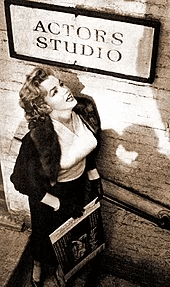
Monroe enjoyed one more reprieve after Some Like It Hot until late 1959 when she appeared in the musical satire; We Should Have intercourse. She picked George Cukor to direct, and she modified a portion of the content that she believed was feeble. She acknowledged the job exclusively because she was behind on her Fox contract. Her regular nonappearances from the set made the film's creation be deferred. Monroe had an illicit extramarital relationship with her co-star, Yves Montand, during the shoot, which was broadly detailed in the press and utilized in the film's exposure crusade. Monroe's last film was John Huston's The Loners, which Mill operator had composed explicitly for her to assume a sensational part. She depicted an as-of-late separated lady who gets to know three older cowpokes, played by Clark Peak, Eli Wallach, and Montgomery Clift. Yet again recording in the Nevada desert from July to November 1960 was troublesome. Monroe and Mill operator's marriage was finished, and he started dating set picture taker Inge Morath. Monroe loathed the way that he played put together her part to some degree concerning her own life and thought it was sub-par compared to the male jobs. Miller's habit of rewriting scenes the night before filming was also a source of contention for her. Her well-being was likewise falling apart: she was experiencing gallstones, and her chronic drug use was extreme to such an extent that her make-up must be applied while she was still sleeping from barbiturates. The recording was stopped in August to permit her to spend seven days in a medical clinic detox. Regardless of her issues, Huston expressed that when Monroe was acting, she was cheerful "was not showcasing an inclination. It was a genuine article. She would search deep within herself for it and bring it to consciousness." Monroe and Mill's operator separated not long after the finishing of recording, and she got a Mexican separation in January 1961. The following month, The Nonconformists was delivered, yet it bombarded the cinema world. Assortment condemned the film's "uneven" character advancement, while Bosley Crowther referred to Monroe as "totally clear and unbelievable" and expressed that "tragically for the film's construction, everything turns on her." The English Film Foundation's Geoff Andrew called it a work of art, Huston researcher Tony Tracy considered Monroe's exhibition the "most experienced understanding of her profession," and The Free's Geoffrey McNab commended her for being "remarkable" in depicting the person's "force of compassion." Monroe was set to star in an NBC TV transformation of W. Somerset Maugham's Downpour; however, the undertaking fell through because the organization would not recruit her favored chief, Lee Strasberg. Rather than working, she was engrossed with medical problems for the initial a half year of 1961. She had a cholecystectomy and endometriosis surgery, and she was hospitalized for four weeks for depression. She got help from ex Joe DiMaggio, with whom she revived a fellowship and dated his companion Plain Sinatra for a considerable length of time. Monroe likewise got back to California for all time in 1961, buying a home at 12305 Fifth Helena Drive in Brentwood, Los Angeles, in mid-1962. Monroe returned after a while in the spring of 1962. She won a Golden Globe for "World Film Favorite" and began filming Something's Gotta Give, a remake of My Favorite Wife, for Fox (1940). MMP was to co-produce the movie, which would be coordinated by George Cukor and star Dignitary Martin and Cyd Charisse. Monroe got sinusitis a couple of days prior to shooting started. Despite clinical guidance to defer creation, Fox started it in late April according to plan. Monroe couldn't work for most of the following month and a half, yet despite various specialists' affirmations, the studio squeezed her by openly blaming her for faking it. She had some time off in front of an audience on May 19 to sing "Blissful Birthday, Mr. President" at President John F. Kennedy's initial birthday festivity at Madison Square Nursery in New York. Her outfit drew consideration: a beige, skintight dress shrouded in rhinestones that caused her to seem exposed. Monroe's visit to New York bothered Fox leaders, who had believed she should drop it. Monroe then, at that point, swam exposed in a pool for a scene in Something's Need to Give. The press was welcome to take photos for advance exposure and distribute them throughout everyday life. This was the first time a significant celebrity posed naked at the pinnacle of their career. When she went on debilitated leave for a couple of days once more, Fox concluded that it couldn't bear the cost of another film falling delayed when it was managing the increasing expenses of Cleopatra (1963). Fox terminated Monroe on June 7 and sued her for $750,000 in punitive fees. Lee Remick supplanted her, yet when Martin wouldn't make the film with anybody other than Monroe, Fox sued him, ending the creation. The studio faulted Monroe for the film's disappointment and started spreading harmful exposure about her, in any event, asserting she was deranged. Fox rapidly lamented its choice and again opened dealings with Monroe later in June; another agreement understanding arrived at later that mid-year, including the re-beginning of Something, Must Give and a featuring job in the dark satire What a Nice job! (1964). She also had plans to appear in a Jean Harlow biopic. Monroe participated in a few exposures and dared to fix her public picture, including interviews with forever and Cosmopolitan, and her most memorable photograph went for Vogue. She and picture taker Bert Harsh worked together on two series of photos for Vogue, one a standard design publication and the other of her presenting bare, which were distributed posthumously under the title The Last Sitting. Death and Funeral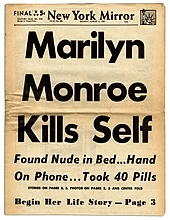
Monroe spent her last days at 12305 Fifth Helena Drive in Los Angeles' Brentwood area. On August 4, 1962, her servant Eunice Murray was at the house. Murray arose at 3 a.m. on August 5 with the inclination that something was off base. She saw the light coming from under Monroe's room entryway however couldn't get a reaction and found the entrance was locked. Murray then called Monroe's specialist, Ralph Greenson, who showed up soon after and broke into the room through a window to find Monroe dead in her bed. Hyman Engelberg, Monroe's doctor, showed up around 3:50 a.m. also, articulated her dead at the scene. The LAPD was informed at 4:25 a.m. Monroe died on August 4 somewhere in the range of 8:30 and 10:30 p.m., and the toxicology report uncovered that the reason for death was intense barbiturate harm. In her blood, she had 8 mg% (milligrammes per 100 millilitres of solution) chloral hydrate, 4.5 mg% pentobarbital (Nembutal), and 13 mg% pentobarbital in her liver. Void prescription jugs were found close to her bed. Monroe's unintentional excess was precluded in light of the fact that the measurements found in her body were a few times higher than as far as possible. The Los Angeles Self Destruction Anticipation Group, which had master information on self-destruction, helped the Los Angeles Province Coroner's Office in their examination. Monroe's primary care physicians expressed that she was "inclined to serious apprehensions and continuous miseries," as well as "sudden and capricious state of mind changes," and that she had gone too far a few times previously, conceivably deliberately. Because of these facts, as well as the lack of any evidence of foul play, deputy coroner Thomas Noguchi ruled her death a suicide. Monroe's startling passing made headline news in both the US and Europe. As per Lois Standard, "the self-destruction rate in Los Angeles is said to have multiplied the month after she passed on; the dissemination pace of most papers expanded that month," and the Chicago Tribune revealed getting many calls from individuals from the public looking for data about her demise. Her demise "ought to act as a horrible illustration to every one of those, whose principal occupation comprises of keeping an eye on and torturing movie stars," said French craftsman Jean Cocteau. At the same time, her previous co-star Laurence Olivier referred to her as "the total casualty of ballyhoo and sensation," and Transport Stop chief Joshua Logan referred to her as "perhaps of the most neglected individual on the planet." Her burial service, hung on August 8 at the Westwood Town Commemoration Park Graveyard, was private, with just her nearest relates in participation. Joe DiMaggio, Monroe's stepsister Berniece Dough puncher Supernatural occurrence, and Monroe's business director Inez Melson coordinated the assistance. Hundreds of people crowded the streets surrounding the cemetery. Monroe was subsequently buried at the Hallway of Recollections in Sepulcher No. 24. A few paranoid fears, including murder and coincidental excess, were proposed in the many years that followed to discredit self-destruction as the reason for Monroe's demise. With the distribution of Norman Mailer's Marilyn: A History in 1973, the hypothesis that Monroe had been killed first acquired legal consideration, and in the years that followed, it became boundless enough for Los Angeles Province Head prosecutor John Van de Kamp to direct a "limit examination" in 1982 to decide if a criminal examination ought to be opened. There was no evidence of wrongdoing discovered. Screen Persona and ReceptionThe 1940s were a brilliant period for intense and savvy entertainers like Katharine Hepburn and Barbara Stanwyck, who took care of ladies who overwhelmed crowds during the conflict. Twentieth Century Fox imagined Monroe as another ten years star who might draw in men to the motion pictures. He considered her trade for the maturing Betty Grable, their generally famous "blonde sensation" of the 1940s. Monroe's star image, according to film scholar Richard Dyer, was created primarily for the male gaze. Monroe was instrumental in shaping her public image from the start, and by the end of her career, she had almost complete control over it. She concocted many of her advertising techniques, shaped kinships with tattle reporters like Sidney Skolsky and Louella Parsons, and practiced command over the utilization of her pictures. She was now and again contrasted with another famous blonde, 1930s film star Jean Harlow, notwithstanding Grable. Monroe, who named Harlow as her young life icon, needed to play her in a biopic and, surprisingly, recruited Harlow's hair specialist to variety her hair, provoking the examination. Monroe's screen persona focused on her light hair and its generalizations, especially idiocy, innocence, sexual accessibility, and simulation. In her movies, she regularly utilized a hoarse, whimsical voice. In interviews, she felt that all that she said was "completely guiltless and uncalculated," satirizing herself with risqué remarks that became known as "Monroeisms." When asked what she was wearing in the 1949 bare photograph shoot, she answered, "I had the radio on." Monroe's characters in her films were typically defined solely by their gender. Her positions were quite often as tune young ladies, secretaries, or models, occupations where "the lady is in plain view, there for the joy of men." Monroe began as a dream boat model, and she was known for her hourglass figure. She was often situated in film scenes to flaunt her breathtaking outline, and she, much of the time, presented like a dream boat in exposure photographs. Her unmistakable, hip-swinging walk caused her to notice her body, procuring her the moniker "the young lady with the level walk." Monroe, as often as possible, donned white to stress her fair hair and caused her to notice herself by wearing uncovering outfits that flaunted her figure. Her exposure stunts habitually elaborate her apparel being either incredibly uncovering or failing, for example, when a shoulder lash of her dress snapped during a public interview. Monroe was depicted in press accounts as the exemplification of the Pursuit of happiness, a young lady who rose from an unfortunate childhood to Hollywood fame. Her encounters in childcare and a shelter were misrepresented, while possibly not altogether manufactured. As per film researcher Thomas Harris, her common roots and absence of family caused her to show up more physically accessible, "the best close companion," rather than her contemporary, Beauty Kelly, who was likewise promoted as an attractive blonde but was viewed as a complex entertainer, out of reach for most of the male watchers because of her privileged foundation. Notwithstanding the way that Monroe's screen persona as a moronic yet visually captivating blonde was a painstakingly created act, crowds and film pundits accepted it was her actual character. This hampered her ability to pursue other roles or gain respect as a businesswoman. Sarah Churchwell, an academic who studied Monroe narratives, stated: The biggest myth is that she was dumb. The second is that she was fragile. The third is that she couldn't act. She was far from dumb, although she was not formally educated, and she was very sensitive about that. But she was very smart indeed-and very tough. She had to be both to beat the Hollywood studio system in the 1950s. The dumb blonde was a role-she was an actress, for heaven's sake! Such a good actress that no one now believes she was anything but what she portrayed on screen. Monroe's sex image status was much of the time quietly spoofed in her movies and public appearances, as per biographer Lois Standard, and "the 'Marilyn Monroe' character she made was a splendid prime example, which remains between Mae West and Madonna in the practice of 20th-century orientation comedians." Monroe expressed that West impacted her, educating her "a couple of stunts - that impression of chuckling at, or taunting her sexuality." She concentrated on parody in classes instructed by Lotte Goslar, a renowned emulate and artist known for her comic shows, and she was likewise taught on film sets by Goslar. Monroe had the line, "I can be brilliant when it's significant. However, most men could do without it," added to her personality's lines in Respectable men Favor Blondies, one of the movies in which she played the original stupid blonde. Monroe turned out to be "basically a commonly recognized name for sex" during the 1950s, as per Dyer, and "her picture must be arranged in the motion of thoughts regarding profound quality and sexuality that described the Fifties in America, for example, Freudian beliefs regarding sex, the Kinsey report (1953), and Betty Friedan's The Ladylike Persona (1963). Rather than the 1940s femme Fatales, Monroe was the primary sex image to introduce sex as regular and without risk by seeming powerless and uninformed about her sex request. Spoto likewise depicts her as encapsulating "the post bellum ideal of the American young lady, delicate, straightforwardly poor, reverential of men, credulous, offering sex without requests," an opinion reverberated by Molly Haskell's explanation that "she was the Fifties fiction, the untruth that a lady had no sexual requirements, that she is there to take care of, or improve, a man's necessities." Dyer has likewise contended that Monroe's light hair turned into her characterizing highlight since it made her "racially unambiguous" and solely white toward the beginning of the social liberties development and that she ought to be seen as an image of prejudice in 20th-century mainstream society. Pennant concurred that it was anything but a fortuitous event that Monroe began a pattern of bleach-blonde entertainers during the social liberties development. Yet, she likewise reprimanded Dyer, bringing up that in her exceptionally pitched private life, Monroe spent time with individuals who were seen as "white ethnics," like Joe DiMaggio (Italian American) and Arthur Mill operator (Jewish). As per Flag, she sometimes tested winning racial standards in her exposure photos; for instance, in a 1951 picture distributed in Look, she was displayed in uncovering clothing while at the same time rehearsing with African American singing mentor Phil Moore. As per Photoplay, Monroe was seen as a particularly American star, "a public establishment too known as sausages, fruity dessert, or baseball." Standard alludes to her as a Populuxe image, a star whose cheerful and impressive public picture "helped the country's suspicion during the 1950s about the Virus War, the nuclear bomb, and the extremist socialist Soviet Association." As per history specialist Fiona Handyside, whiteness/blondness was related to American innovation and neatness by French female crowds. In this way, Monroe represented a cutting-edge, "freed" lady whose life happens in the open arena. Laura Mulvey, a film student of history, depicted her as a support for American purchaser culture: If America was to export the democracy of glamour into post-war, impoverished Europe, the movies could be its shop window ... Marilyn Monroe, with her all-American attributes and streamlined sexuality, came to epitomise in a single image this complex interface of the economic, the political, and the erotic. By the mid-1950s, she stood for a brand of classless glamour, available to anyone using American cosmetics, nylons and peroxide. Twentieth Century Fox capitalized on Monroe's popularity by developing several lookalike actresses, including Jayne Mansfield and Sheree North. Different studios endeavored to make their own Monroes, incorporating Widespread Pictures with Mamie Van Doren, Columbia Pictures with Kim Novak, and The Position Association with Diana Dors. LEGACY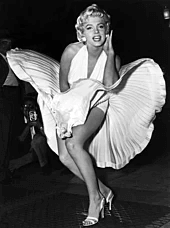
"As a symbol of American mainstream society, Monroe's couple of opponents in prominence incorporate Elvis Presley and Mickey Mouse. No other star has at any point propelled many such feelings - from a desire to feel sorry for, from jealousy to regret," as per The Manual for US Mainstream society. Monroe was named "the most captured individual of the 20th century" by artistry antiquarian Gail Levin. The American Film Organization called her the 6th most prominent female screen legend in American film history. The Smithsonian Foundation named her one of the "100 Most Critical Americans Ever," and both Assortment and VH1 positioned her among the top ten most prominent mainstream society symbols of the 20th century. Monroe has been the subject of many books. She has propelled specialists and performers like Andy Warhol and Madonna and has been the subject of various movies, plays, dramas, and tunes. Her picture and name have been authorized for many items, and she has shown up in ads for brands, for example, Max Component, Chanel, Mercedes-Benz, and Absolut Vodka. Monroe's enduring popularity stems from her contradictory public image. From one viewpoint, she stays a sex symbol, a delight symbol, and one of the most notable stars of exemplary Hollywood films. Then again, she is associated with her pained confidential life, shaky adolescence, the battle for proficient regard, her demise, and the paranoid notions that encompassed it. She has been expounded on by orientation and women's liberation researchers and columnists like Gloria Steinem, Jacqueline Rose, Molly Haskell, Sarah Churchwell, and Lois Standard. Some, including Steinem, considered her a survivor of the studio framework. Monroe's fame and grieved private life are connected to more extensive conversations about current peculiarities like broad communications, notoriety, and shopper culture. As per scholastic Susanne Hamscha, Monroe "never totally arranged in one time or spot," yet has turned into "a surface on which stories of American culture can be (re-)built," and "works as a social kind that can be duplicated, changed, converted into new settings, and sanctioned by others. "Similarly, Banner has referred to Monroe as the "eternal shapeshifter," whom "each generation, even each individual. To their specifications" re-creates. Monroe stays a social symbol. However, her inheritance is an entertainer pundit. Pauline Kael composed that she could not act and, on second thought, "utilized her absence of an entertainer's abilities to entertain general society." David Thomson referred to her collection of work as "meager." She had the mind, vulgarity, or distress to transform cheesecake into acting - as well as the other way around; she did what others with "great taste" wouldn't do." Conversely, Peter Bradshaw composed that Monroe was a skilled comic who "knew how parody worked," and that's what Roger Ebert gave a statement, "Monroe's erraticism and depressions on set became famous, yet studios set up with her long after some other entertainer would have been debased because what they got back on the screen was worth the effort." As per Jonathan Rosenbaum, "she unobtrusively undermined the misogynist content of her material" and that "the certain trouble individuals have knowing Monroe's knowledge as an entertainer appears to be established in the philosophy of a harsh time when very female ladies shouldn't have been shrewd."
Next TopicLionel Messi
|
 For Videos Join Our Youtube Channel: Join Now
For Videos Join Our Youtube Channel: Join Now
Feedback
- Send your Feedback to [email protected]
Help Others, Please Share









